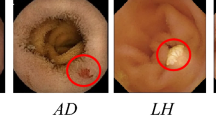Abstract
Wireless capsule endoscopy (WCE) is a recently established imaging technology that requires no wired device intrusion and can be used to examine the entire small intestine non-invasively. Determining bleeding signs out of over 55,000 WCE images is a tedious and expensive job by human reviewing. Our goal is to develop an automatic obscure bleeding detection method by employing image color features and support vector machine (SVM) classifier. The bleeding lesion detection problem is a binary classification problem. We use SVMs for this problem and a new feature selection procedure is proposed. Our experiments show that SVM can be very efficient in processing unseen instances and may yield very high accuracy rate, in particular with our new proposed feature selection. More specifically, for this bleeding detection problem, training an SVM with 640 samples can be completed in as little as 0.01 second on a Dell workstation with dual Xeon CPUs, and classifying an image using the trained SVM can be done in as little as 0.03 milliseconds. The accuracy for both sensitivity and specificity can be over 99%.
Similar content being viewed by others
References
Adler DG, Gostout CJ (2003) Wireless capsule endoscopy. Hosp Physician 14–22
Boser BE, Guyon IM, Vapnik V (1992) A training algorithm for optimal margin classifiers. In: Fifth annual workshop on computational learning theory. Assoc Comput Mach, New York
Chang CC, Lin CJ (2001) LIBSVM: A Library for Support Vector Machines. (software available at http://www.csie.ntu.edu.tw/~cjlin/libsvm)
Cortes C, Vapnik V (1995) Support vector networks. Mach Learn 20:273–297
Cristianini N, Shawe-Taylor J (2000) Support vector machines and other kernel-based learning methods. Cambridge University Press, Cambridge
Dumais S, Platt J, Heckerman D, Sahami M (1998) Inductive learning algorithms and representations for text categorization. In: Proceedings of the 7th international conference on information and knowledge management, pp 148–155
Fireman Z, Glukhovsky A, Jacob H, Lavy A, Lewkowicz S, Scapa E (2002) Wireless capsule endoscopy. Israel Med Assoc J 4:717–719
Majewski P, Jedruch W (2005) Endoscopy images classification with kernel based learning algorithms. In: Innovations in applied artificial intelligence, pp 400–405
Osuna E, Freund R, Girosit F (1997) Training support vector machines: an application to face detection. In: Proceedings of the IEEE computer society conference on computer vision and pattern recognition, pp 130–136
Vapnik V (1995) The nature of statistical learning theory. Springer, New York
Vapnik V (1998) Statistical learning theory. Wiley, New York
Author information
Authors and Affiliations
Corresponding author
Additional information
This work was partially supported by National Science Foundation grant IIS-0722106, IIS-0737861, and Texas ARP 003594-0020-2007.
Rights and permissions
About this article
Cite this article
Liu, J., Yuan, X. Obscure bleeding detection in endoscopy images using support vector machines. Optim Eng 10, 289–299 (2009). https://doi.org/10.1007/s11081-008-9066-y
Received:
Accepted:
Published:
Issue Date:
DOI: https://doi.org/10.1007/s11081-008-9066-y




